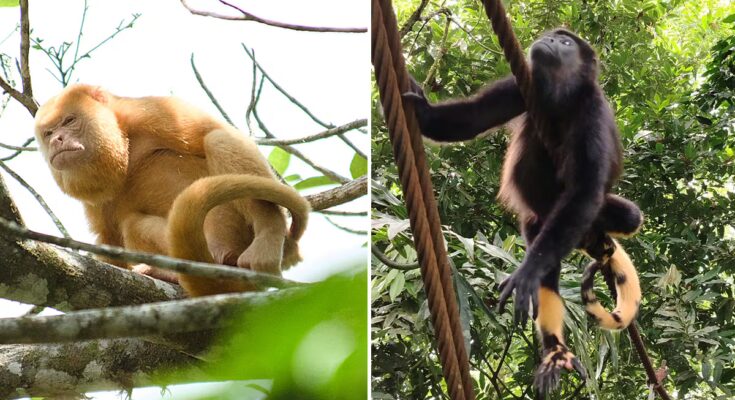The chameleon, octopus, cuttlefish or snowshoe hare change color naturally, but the appearance of a white Iberian lynx in the mountains of Jaen is surprising, even incredible. It is a female, known as Satureja, which has lost its natural color, those brown and orange tones so characteristic of the species. However, it maintains the black spots, typical of every lynx: a natural DNI that they retain throughout their lives and which allows them to differentiate one individual from another.
Nobody knows the reason for this striking change in fur, which had already been found previously in another specimen. Javier Salcedo, coordinator of the Iberian lynx reintroduction program in Andalusia, suggests that it is a temporary depigmentation due to external factors – environmental or stress -, which would leave aside the genetic mutations that cause albinism or leucism.
They have as an example the case of another female, who could be related to this one, to whom the same thing happened and after a while she recovered her natural tones. However, the Department of Sustainability and the Environment of the Regional Council of Andalusia refers to the ongoing investigation.
“When an animal does not change color normally and does so suddenly, the environmental factor cannot be ruled out,” explains Ismael Galván, senior scientist at the CSIC of the National Museum of Natural Sciences (MNCN) and pigmentation specialist. The problem is that currently “we don’t know well the external agents that could cause these changes and it is possible that environmental pollution could influence the coloration,” he says. This is why it is so important, he reiterates, to investigate the origin of this type of anomalies.
Galván cites as an example the anomalous changes observed in the pigmentation of mantled howler monkeys (Alouatta palliata) from Costa Rica with whom he worked. For about ten years these primates have begun to change color dramatically. “It’s very surprising, because they go from being completely black to individuals appearing with parts between orange and yellow,” he describes. At first there were few of them and the transformation affected the extremities, legs or tail, “but there has been an increase in both the number of specimens affected and the extent of the altered body areas, and now there are entire orange howler monkeys.”
What are the causes? “There is a lack of research and it’s not just monkeys, these anomalies have also been detected in porcupine or toucan specimens,” he replies. Melanins are responsible for the black, brown, reddish and yellowish tones of the skin, hair, fur or plumage. In the case of howler monkeys, the melanin responsible for black tones is lost in favor of orange, while in the white lynx that appeared in Jaén the process is reversed, it loses orange and retains black.
Exposure to plant protection products used in plantations near where they live may be behind the tone-changing anomalies in monkeys. “But it is a hypothesis that we have not yet been able to investigate further,” explains Galván.
The most common thing in cases of animals born with a pigmentation different from the natural one is that a genetic mutation has occurred. Natural selection normally ensures that that animal dies. One of these alterations is albinism, which appears by chance and causes the total absence of melanin. In case of Satureja it was discarded, because it should be completely white, without black spots. The gorilla Snowflake He was the protagonist of one of the most famous cases of albinism in the world. He was captured as a baby in Guinea in 1966 and lived in the Barcelona Zoo until his death in 2003, aged 40.
Another genetic anomaly is leucism, which consists in the fact that the animal produces melanin, but it does not reach certain areas of the body that appear white or very light. That doesn’t even seem to be the case, because Satureja It doesn’t seem that way.
Furthermore, both alterations (albinism and leucism) manifest themselves at birth and these two lynxes, according to what the coordinator of the lynx reintroduction program told EL PAÍS, came into the world with their usual colors. The depigmentation occurred later.
Control of 700 genes
Lluis Montoliu, researcher at the CSIC and the Biomedical Research Network Center on Rare Diseases of the National Biotechnology Center, explains that “there are almost 700 genes that, in one way or another, directly or indirectly, control the pigmentation of animals (and us), of the approximately 20,000 that both we and the lynx have, given that we are both mammals.” Of these, only 22 cause albinism if mutated and a few others cause leucism.
But there are many others that “can alter pigmentation in multiple ways,” he adds. For example, it fades gradually, as happens to silver horses, which are born pigmented, but lose their color until they become white. “Uncle, the horse from Pippi Longstocking (the children’s series), was one of these specimens, on which before each scene they painted the black circular dots that we all remember,” he recalls.
This horse is a model of vitiligo, “perhaps one explanation why this lynx may have lost pigmentation on its body.” This skin disease has both genetic causes (there are at least 40 genes whose alteration predisposes to vitiligo) and environmental: friction or exposure to chemical substances that can cause loss of pigmentation due to the death or disappearance of melanocytes, the cells that produce melanin.
But to know for sure what may have happened to this lynx, “we should first sequence its genome and see if it carries mutations in any of the 700 genes.” It would also be necessary to do “a histological analysis (tissue study) of your skin” and check if it has no pigments because your melanocytes do not produce them or because you have lost them. “The latter would allow us to suggest that the cause of this pigment loss could be related to vitiligo,” says Montoliú.
Knowing the genome of Satureja It would be enough to take some of their hair, excrement, saliva… But for histological analysis it is necessary to carry out a skin biopsy. What does it mean to capture Saturejaa mission that seems complicated, given that he was born in the wild and does not have a GPS location.
He is also in good shape, has had a litter and doesn’t seem to have problems hunting and feeding despite his white color. The technicians of the species recovery program capture some specimens every year to verify the status of the population, but without looking for any specific individual.



